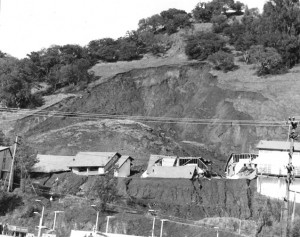A new generation of resident was moving into San Anselmo as the ’70s began, the first wave of the young, college-educated Baby Boomers. Culturally and socially, the times were changing.
Many were members of the “counter-culture,” fresh from San Francisco’s Summer of Love or anti-Viet Nam War protests and lured by the tranquility of “Marvelous Marin.” With them came music.

Lion’s Share Advertisement, 1969
In the early ’70s, San Anselmo was home to Marin’s premiere rock venue, the Lion’s Share located near United Market. On the other side of town, in a former church above Lansdale Station, music history was being made as the recording studio for Marin’s own and still-performing Sons of Champlin. Downtown, San Anselmo boasted what was the rage in the ’70s: its own “fern bar,” first called Ned’s, then Ted’s, and now known as Marinitas.
The era of hot tubs and peacock feathers had arrived-but so had gasoline rationing and water rationing. In San Anselmo, cars lined up at the Town’s nine service stations to get gas on specified days only, a nationwide response to the Oil Embargo of 1973. In a region known for its rainfall, in 1976-1977 Marin was in the throes of the worst drought in Water District history. Residents were put on a strict rationing plan that inspired the ditty: “If it’s yellow, let it mellow.”

Red Hill Slide, 1967
The drought was an anomaly. Heavy rain is the norm, as the Southern California-based builders of a four-unit apartment complex learned the hard way in 1967. Completed but not occupied, the apartments were destroyed in a slide precipitated by a January deluge. What remains of the complex is the deep cut alongside the western slope of Red Hill.
On another January day 25 years later, San Anselmo would be drenched again, so much so that by the end of the three-day storm, upwards of three-feet of water coursed through downtown and into businesses along San Anselmo Avenue.

1982 Flood
The January 4 Flood of ’82 was “a flood of record.” It made sandbagging an annual winter ritual-and spurred the Town to reinstate the warning horn in the Town Hall tower: five blasts repeated three times remains the call to arms.
Downtown San Anselmo had flooded before, but the only proffered solution to controlling the waters had been rejected in 1965. That year the Council opposed the U.S. Army Engineers plan to build a concrete channel through San Anselmo-similar to the one constructed in Kentfield and Ross-citing aesthetics and in direct response to public protest against it.
As San Anselmo hit the ’80s, BMWs and ever-increasing, triple-digit home prices became the norm. San Anselmo was no longer the small town it had been, but it didn’t say goodbye to the past entirely. It embraced it to become “the Antique Capital of Northern California.”
Antiques weren’t the only product that put San Anselmo on the map. In 1979, avid bikers Gary Fisher and Charlie Kelly pooled their cash – $200 – and opened MountainBikes on the corner of San Anselmo Avenue and Center Boulevard, the first-ever business dedicated solely to building and selling what the two created out of personal necessity. In the process, they helped launch a worldwide phenomenon.
Another worldwide phenomenon-Lucasfilm-found an early home in San Anselmo: Before Skywalker Ranch opened in Nicasio, movie magic was afoot in our downtown. At Lucasfilm’s Sprocket Systems, which opened in 1979 at 321 San Anselmo Avenue, film editors worked upstairs on “Raiders of the Lost Ark” and “The Empire Strikes Back” while sound editors downstairs worked on “Alien” and “E.T.” Kentfield resident Pat Walsh, “discovered” while shopping at Seawood Photo, provided the voice for the loveable alien, with the help of actress Debra Winger. Sprocket’s parking lot was also notable: It’s where Harrison Ford practiced snapping a bullwhip for his role in “Raiders.” Sprocket’s work on “The Return of the Jedi” came to a halt when the Flood of 1982 ruined equipment. The division moved to Lucafilm’s Kerner complex in March of that year.
At the peak of San Anselmo’s post-production era, another space was rented on Tunstead Avenue to house Lucasfilm’s new Computer Division, located initially on Bank Street. The division would move to the Industrial Light and Magic complex in San Rafael before it was spun off in 1986, relocated to Point Richmond, and became what it is today, the Oscar-winning Pixar Animation Studios.

